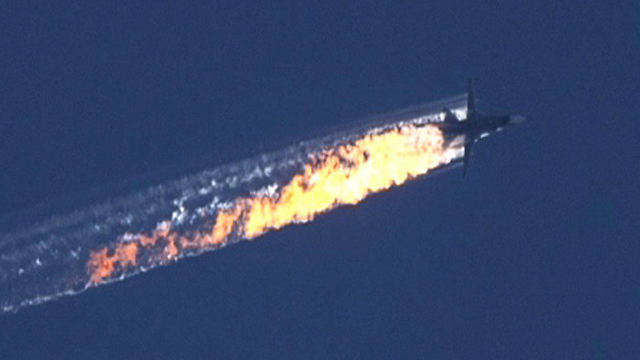
The downing of a Russian Su-24 fighter bomber by Turkish Air Force F-16's adjacent to the Turkish Syrian border on Tuesday provided yet another example of the increasing complexity which has emerged as a result of the sheer number of combat aircraft operating above the failing state.
The growing presence of foreign combat aircraft in Syrian airspace has created serious complications for regional air forces, which previously only had to contend with a bruised but not beaten Syrian Air Force.
Fourteen air forces have begun operating in Syrian airspace as a result of Operation Inherent Resolve, the air coaliton against ISIS. The air branches of the Syrian, Russian, Israeli, American, Jordanian, Australian, French, British, Turkish. Saudi, Canadian, Qatari, French and Bahraini armed forces have all operated within the Syrian airspace since the operation's onset.
Israel, a regional power, was reported to have conducted several air strikes in Syria before the operation. However, the number of strikes attributed to the Israeli Air Force have multiplied in the last year. The strikes are said to have primarily targeted shipments of advanced weapons systems which are slated for delivery to Hezbollah.
The airport in Damascus and the sea port in Latakia are said to be major pipelines, which are used to transfer advanced Iranian weapons to the Lebanese terror group. The Israel Air Force had operated in Syrian airspace with relative ease, a reality which no longer exists due to the air campaign. The strategic need to maintain operational flexibility above Syria recently led Russian and Israeli defense officials to establish joint aerial coordination teams, which are meant to help avoid inadvertent conflict.
Israel's reported strikes in Syria are dwarfed by daily US operations in the airspace above Syria. The US is currently among the most frequent operators above Syria, with a variety of manned and unmanned aircraft conducting bombing, air support, and intelligence missions in and around the contested air space. The US military has launched airstrikes targeting ISIS and Al Qaeda from aboard the USS Carl Vinson aircraft carrier, as well as with land based aircraft from Al Udeid Air Base in Qatar, and more recently Incrilik Air Base in Turkey.
France aircraft were the most recent addition to the air war in Syria, after a decision was made to join the coalition effort in the wake of a major ISIS backed terror attack in Paris. The first French airstrikes were launched using aircraft from the Charles de Gaulle aircraft carrier, which is currently in the eastern Mediterranean. The location of the French carrier group means that most of the strike aircraft overfly Israel and Jordan or Turkey on their path into Syria and Iraq. The additional traffic in the congested airways and chances for confrontation with Russian and Syrian aircraft have grown as a result.
Several other coalition allies have also participated in the strikes, albeit with much less consistency. The allies, which include the Gulf Arab States, launch strike missions which involve numerous aircraft flying long distances before entering Syrian airspace. The Jets enter the airspace from a variety of locations including Jordan and Iraq, creating an increased likelihood for an unplanned encounter. The sheer number of aircraft taking part in the airstrikes, which include various drones, ELINT (electronic intelligence), and refueling aircraft have created a serious challenge for the campaign's military planners.
The challenging conditions are further exacerbated by the lack of coordination between the coalition and the Syrian and Russian air forces. The fear being that Russian and Syrian aircraft will lock onto coalition aircraft while conducting operations, or vice versa, within the congested airspace. While the opposing sides are likely to meet in the congested airspace, the potential for full blown aerial combat is low; as such incidents are immediately reported and coordinated at the highest levels between the countries. A great example of which was evident in a recent video which showed a Russian fighter aircraft intercepting a US reaper drone over Syria.
But the potential for clashes exists, as do political sensitivities, which often lead to hasty decisions. NATO member Turkey first experienced the dangerous reality above Syria in June 2012, after a Turkish F-4 reconnaissance aircraft was shot down by a Syrian missile battery. The interception spurred a firm response from Turkey, who later shot down a Syrian Mig and helicopter in March of 2014, after they reportedly breached Turkish airspace. In September of that year Israel had its first taste of what would come when an Israeli patriot missile battery shot down a Syrian Su-24 fighter after it breached Israeli airspace by 800 meters.
As Russia began building its airbase in Syria, the increasingly congested airspace began producing new incidents of reported airspace violations. On October 3, a pair of Russian jets violated Turkish airspace above the Hatay province, which borders Syria's western coast. A Russian aircraft reportedly locked onto a Turkish jet a mere day later in the same area.
Turkish F-16's seemingly repeated history on Tuesday, when they shot down the Russian Su-24, which had apparently crossed into Turkish airspace. According to the Turkish military the aircraft had been warned 10 times in five minutes.
But this latest incident in the increasingly fragile and congested airspace in and around Syria only seemed to further prove the growing complexities faced by the perpendicular air campaigns. Complexities which are only likely to grow as Russia nearly doubles its aerial fleet in the war torn nation. As the Russian base in Syria grows, so too do the chances for more incidents of a similar nature in the airspace above Syria.


















